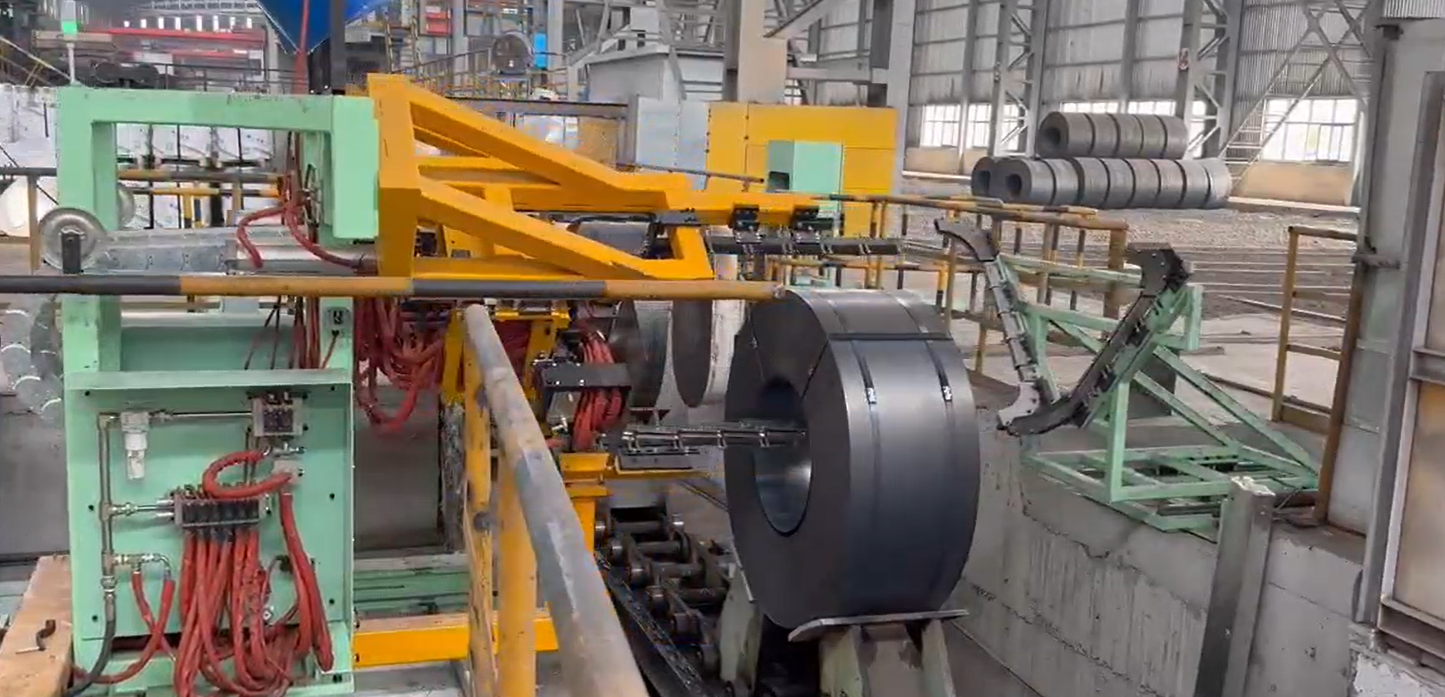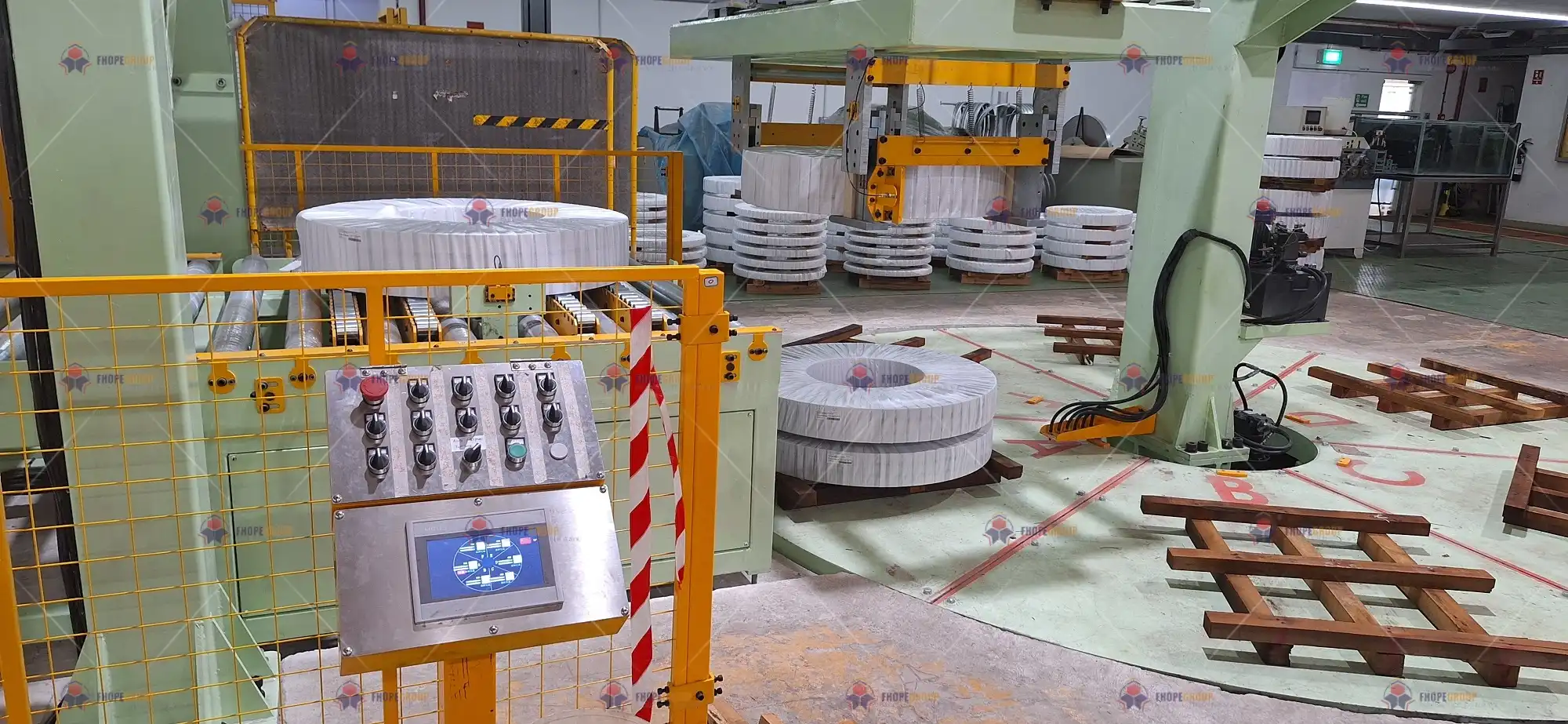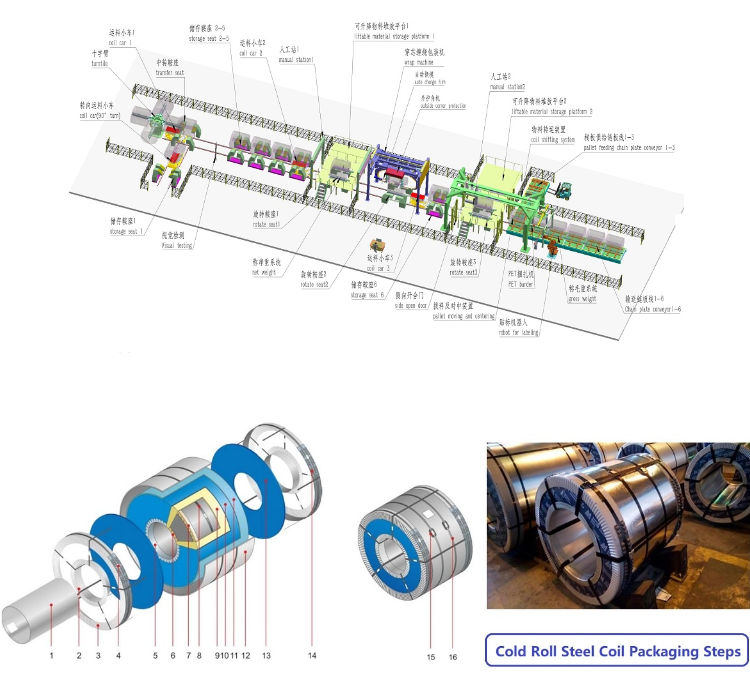Running a steel or aluminum facility is a constant battle. You fight against rising energy costs, global competition, and the daily pressure to ship products on time. I know this because I’ve spent my entire career in this industry. A major source of this pressure often comes from the very last step in your process: the packing line. Slow, manual packing can create a bottleneck that holds your entire operation hostage, causing delays and eating into your hard-earned profits. It’s a frustrating problem when you know your production lines can do more. But forward-thinking leaders are finding a way to break this chain. They are looking at their packing line not as a cost center, but as a strategic opportunity.
Leading Greek manufacturers are investing in high-speed coil packing technology primarily to slash operational costs, dramatically increase throughput, and improve the quality and consistency of their final product. By automating this critical final stage, they transform a labor-intensive bottleneck into a streamlined, efficient, and reliable part of their production flow, boosting their competitiveness in the demanding European and global markets.

This investment is more than just a simple equipment upgrade. It represents a fundamental shift in how these companies approach their operations. It’s about building resilience against market volatility and future-proofing their business. I've seen this transformation happen many times. The results are not just about speed; they ripple through the entire organization, from the factory floor to the balance sheet. So, let’s explore the specific reasons why this technology is becoming a critical investment for Greece's industrial leaders. We will break down how it solves some of the most persistent challenges in the industry.
How does high-speed packing directly address rising operational costs?
You see the numbers every month. Labor costs creep up. The price of packing materials like stretch film and strapping is unpredictable. Energy bills are a constant worry. These are the operational costs that can slowly erode your profitability. You might think this is just the cost of doing business. But every euro spent on inefficient manual labor or wasted material is a euro that could have been reinvested in growth. What if you could control these variables? High-speed automated packing lines are designed to do exactly that. They attack these core costs with mechanical precision and unwavering efficiency.
High-speed packing directly addresses rising operational costs by automating labor-intensive tasks, which significantly cuts down on manpower needs. It also uses materials with high precision, reducing waste of stretch film and strapping. And modern, energy-efficient motors lower electricity consumption per coil, leading to more predictable and lower overall operational expenses.

Dive Deeper: Breaking Down the Cost Savings
Let's get specific about where the savings come from. This isn't theoretical; it's based on what I’ve implemented for clients and in my own factory. The cost benefits are tangible and measurable. An owner like Javier Morales would demand this level of analysis before signing off on any purchase order.
Labor Cost Reduction
A typical manual packing station for steel or aluminum coils requires a team of two to four workers per shift. They are responsible for moving the coil, applying VCI paper or film, wrapping it, and strapping it. This is physically demanding work and carries a risk of injury. An automated high-speed line reduces that team to a single supervisor. This person's job is to oversee the machine's operation, load consumables, and manage the HMI (Human-Machine Interface). The direct labor savings are immediate and significant.
When I started my own factory, moving my best people from manual packing to more skilled roles was one of the best decisions I made. It didn’t just save money; it improved morale and allowed us to focus on quality control and process improvement. For a Greek manufacturer facing a competitive labor market, this is a powerful advantage. It also reduces costs associated with workplace injuries and employee turnover.
Material and Energy Optimization
Manual packing is inherently inconsistent. One worker might apply three layers of stretch film, while another applies five. This inconsistency leads to massive waste over time. A machine, on the other hand, is programmed for precision.
| Feature | Manual Packing | Automated High-Speed Packing | Typical Savings |
|---|---|---|---|
| Stretch Film Usage | Highly variable, often excessive | Precise, programmed for optimal stretch | 20-30% |
| Strapping | Inconsistent tension, potential waste | Uniform tension, precise placement | 5-10% |
| VCI Paper/Film | Manual cutting leads to waste | Cut-to-length for each coil size | 10-15% |
| Energy | N/A (Manual Labor) | Efficient motors, standby modes | Lowers overall plant kWh |
An automated wrapper pre-stretches the film to its maximum potential, meaning you use less film to achieve a more secure wrap. The system applies the exact number of layers needed for a specific customer's requirements, which can be saved as a recipe in the machine's HMI. There is no guesswork. Similarly, modern machines use energy-efficient servo motors and go into a low-power standby mode when idle, unlike older hydraulic systems that run constantly. This reduces the unit energy cost for every coil that leaves your plant.
What makes this technology a reliable replacement for aging equipment?
If you're running equipment that's over 15 years old, you know the feeling. You walk the factory floor and hold your breath, hoping the old wrapper makes it through another shift. Unexpected downtime is your worst enemy. It doesn't just stop the packing line; it creates a backlog that can halt your entire production process. Finding spare parts for obsolete machinery can feel like a treasure hunt with no map. This unreliability is a hidden cost and a massive source of stress. Modern high-speed technology is engineered specifically to solve this problem. It is built for the "always-on" demands of a modern factory.
This new technology is a reliable replacement for aging equipment because it is constructed with modern, durable components and smart features like predictive maintenance sensors. The use of standardized parts from global brands like Siemens or Allen-Bradley ensures that spares are readily available, drastically minimizing downtime and providing consistent, long-term operational stability.

Dive Deeper: From Reactive Repairs to Proactive Uptime
The philosophy behind modern machine design is completely different from that of 20 years ago. It's about preventing failures, not just fixing them. A CEO like Javier, whose goal is to push equipment availability to 95%, understands that this requires a new approach to maintenance and technology.
The Problem with Legacy Systems
Aging packing machines are often a collection of complex mechanical and pneumatic systems. These are common points of failure:
- Worn Mechanical Parts: Gears, chains, and sprockets wear down over time, leading to imprecise movements and eventual breakdown.
- Outdated PLCs: The "brain" of the old machine may be a PLC that is no longer supported by the manufacturer. If it fails, you may not be able to find a replacement.
- Pneumatic and Hydraulic Leaks: Older systems are prone to leaks, which reduce efficiency and create safety and environmental hazards.
I remember visiting a client in Greece whose main packing line relied on a custom-made gearbox. When it failed, they faced a six-week shutdown while a new one was fabricated. That single event cost them a major order. This is the risk of relying on legacy equipment.
Designing for Reliability and Maintenance
Modern high-speed lines are designed to eliminate these weak points.
- Servo Drives: Complex mechanical linkages are replaced with simple, highly accurate, and reliable servo motors. This reduces the number of moving parts that can wear out.
- Predictive Maintenance: We integrate IoT sensors that monitor key components. These sensors track motor temperature, bearing vibration, and power consumption. The system can alert a supervisor before a part fails, allowing maintenance to be scheduled during planned downtime. This is the core of predictive maintenance and a key step in any digitalization strategy.
- Standardization: We build our machines using components from globally recognized brands.
| Aspect | Aging Equipment | Modern High-Speed Line |
|---|---|---|
| Core Technology | Complex Mechanical, Pneumatic | Simple, Servo-Driven |
| Maintenance | Reactive (Fix when it breaks) | Proactive (Predictive alerts) |
| Component Sourcing | Difficult, often custom parts | Standardized, globally available |
| Downtime | High, Unpredictable | Minimal, Scheduled |
As an engineer, this shift is exciting. But as a factory owner, it's essential. Reliability isn't just a feature; it's the foundation of a stable and profitable operation.
Can automated packing lines truly improve market responsiveness?
The global metals market is anything but stable. Customer demands can change overnight. One week, a major order requires thousands of large master coils. The next, a new customer in the automotive sector needs small, tightly wrapped slit coils with specific labeling, delivered on a just-in-time basis. If your packing line is slow and inflexible, it can't adapt. You either have to turn down orders or face production chaos trying to keep up. This lack of agility makes you vulnerable to competitors who can move faster. An automated packing line changes this dynamic completely. It gives you the speed and flexibility to say "yes" to more opportunities.
Yes, automated packing lines dramatically improve market responsiveness. Their high speed clears coils from the production floor faster, and their programmable nature allows for rapid changeovers between different coil sizes, wrapping specifications, and labeling requirements. This transforms the packing station from a rigid bottleneck into a flexible asset that enables a company to meet diverse and urgent customer demands.

Dive Deeper: Building Agility into Your Operations
Market responsiveness isn't just about being fast. It's about being flexible. For a steel mill owner, this agility translates directly into higher capacity utilization and the ability to capture high-margin, specialized orders.
Eliminating the Final Bottleneck
In many factories I've visited, the slitting and rolling lines are incredibly fast and efficient. They can produce coils much faster than the packing team can handle them. The result is a yard full of unprotected, unpackaged coils waiting to be processed. This "work-in-progress" inventory ties up capital, takes up valuable space, and increases the risk of damage or corrosion.
A high-speed packing line is designed to match the speed of your production equipment. A line that can wrap and strap a coil in 60-90 seconds keeps pace with a modern slitter. This synchronicity means coils move smoothly from production to the shipping dock, freeing up space and capital. It allows your entire plant to operate closer to its true maximum capacity.
The Power of Programmable Recipes
Imagine a customer calls with an urgent, complex order. They need 50 slit coils, each with a different width, wrapped in VCI paper, then stretch film, with circumferential and eye-to-sky strapping, and a specific label format. On a manual line, this would be a nightmare of confusion and errors.
On a modern automated line, this is simple. The operator pulls up the customer’s "recipe" on the HMI screen. The system automatically adjusts the conveyor guides, the wrapping arm position, the strapping head, and the label printer. The ability to save hundreds of these recipes means you can switch from one complex job to another in minutes, not hours. I worked with a Greek aluminum producer who won a major contract with a German car manufacturer precisely because of this capability. Their new automated line was the only way they could meet the strict just-in-time and SKU variation requirements. It opened an entire new market for them. This is what true market responsiveness looks like.
What is the real ROI of investing in a high-speed coil packing line?
This is the most important question for any business leader. A new packing line is a significant capital expenditure. You need to be confident that the return will justify the cost. It’s easy to get "sticker shock" and focus only on the upfront price. But as I learned when building my own business, the most expensive machine is often the one you don't buy. The hidden costs of inefficiency, downtime, material waste, and lost opportunities associated with an old system are a constant drain on your resources. The real ROI of a modern line is phenomenal when you look at the complete picture.
The real Return on Investment (ROI) from a high-speed coil packing line is calculated from a powerful combination of direct cost savings in labor and materials, increased revenue through higher throughput, and significant "soft" returns like improved safety and enhanced market reputation. Most businesses see a full payback on their investment within 18 to 36 months.

Dive Deeper: A Clear Path to Profitability
To understand the ROI, we need to look at both the "hard", easily quantifiable savings and the "soft", strategic benefits. A pragmatic leader like Javier needs to see both to make an informed decision.
Calculating the Hard Savings
Let's put some numbers to this. This is a simplified model, but it reflects the analysis we do with our clients.
| Example: Annual Cost Comparison (Single Shift) | Cost Category | Annual Cost (Manual Line) | Annual Cost (Automated Line) | Annual Savings |
|---|---|---|---|---|
| Labor (3 workers @ €35k/yr) | €105,000 | €45,000 (1 supervisor) | €60,000 | |
| Material Waste (Film, Straps) | €25,000 | €10,000 (15% savings) | €15,000 | |
| Product Damage/Rework | €20,000 | €5,000 | €15,000 | |
| Downtime Costs (Lost Prod.) | €30,000 | €5,000 | €25,000 | |
| Total Annual Operating Cost | €180,000 | €65,000 | €115,000 |
If the total investment for a new line is, for example, €250,000, the simple payback period is calculated as:
Payback Period = Total Investment / Annual Savings = €250,000 / €115,000 = 2.17 years.
A payback period of around two years for major industrial equipment is an excellent return. This calculation doesn't even include the revenue from the extra capacity the new line unlocks.
The Equally Important Soft Returns
The financial calculation is compelling, but the strategic benefits are what truly secure a company's future.
- Enhanced Safety: Automating the heavy lifting and repetitive motions of packing drastically reduces the risk of back injuries and other workplace accidents. This leads to a safer work environment and potentially lower insurance costs.
- Improved Quality & Reputation: A perfectly packed coil arrives at your customer's facility clean, dry, and undamaged. This consistency builds trust and strengthens your reputation as a high-quality supplier. You are no longer just selling steel; you are selling reliability.
- Future-Proofing: A modern packing line is a node in your digital factory. It connects to your MES and ERP systems, providing the data needed for the smart manufacturing goals that leaders like Javier are pursuing. It's not just a machine; it's a platform for growth.
When I invested in my first automated line, it was the ROI calculation that convinced my head, but it was these strategic benefits that drove our success.
Conclusion
Investing in high-speed coil packing technology is no longer a luxury for Greek manufacturers. It is a critical strategic move for future growth, cost control, and competitiveness in a tough global market.





